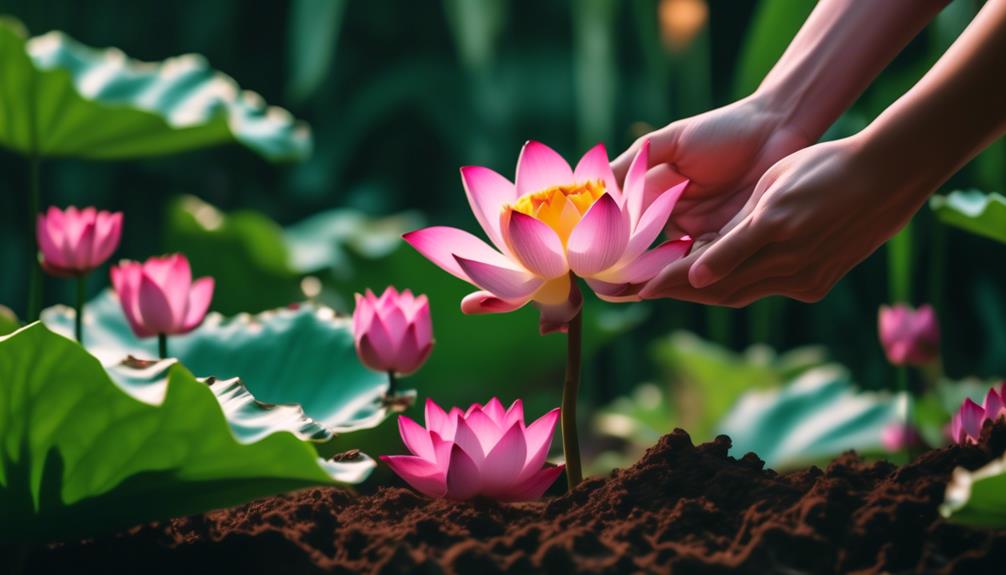The Tiger Lotus, with its alluring presence and captivating colors, has captured the attention of aquarium enthusiasts around the world. This aquatic plant, known for its graceful demeanor and vibrant foliage, adds an unparalleled elegance to any fish tank.
But how can one truly unleash the full beauty of a Tiger Lotus? In this article, we will explore the secrets behind successfully planting, growing, and maintaining this exquisite aquatic gem. From the initial steps of bulb arrival to the art of proper pruning, we will uncover the essential techniques that will ensure the Tiger Lotus thrives and flourishes.
So, if you're ready to embark on a journey towards unlocking the mesmerizing allure of this remarkable plant, then let us dive into the world of the Tiger Lotus.
Key Takeaways
- Prioritize the health of the bulb for vitality and growth
- Provide medium to high lighting for enhanced redness
- Regularly monitor and adjust water parameters for plant health
- Pruning and propagation are important for maintaining the plant's appearance and growth
Planting and Growing a Tiger Lotus
When embarking on the journey of planting and growing a Tiger Lotus, it is crucial to prioritize the health of the bulb, as it serves as the foundation for the plant's vitality and flourishing growth. To ensure successful planting, it is important to follow proper techniques and care for the bulb.
Upon arrival, the bulb is usually found in a plastic pot covered in rock wool, with small leaves that may be damaged or melt away. It is essential to remove the bulb from the pot and rinse off any debris. When planting, gently push one-third of the bulb into the substrate, making sure that the shoots or leaves are above the ground. Avoid burying the entire bulb, as this can lead to rotting. Wait for the bulb to become waterlogged and sink, as the roots will anchor it in place.
In terms of care and maintenance, it is recommended to feed comprehensive fertilizers like Easy Green and Easy Root Tabs. Additionally, providing medium to high lighting is crucial for enhancing the redness of the leaves. Some Tiger Lotus varieties have green leaves with red variegation, while others have red leaves with reddish-purple striping.
Pruning and Propagating Tips
Continuing our exploration of Tiger Lotus care and maintenance, the next aspect to delve into is the art of pruning and propagating this beautiful aquatic plant. Proper pruning techniques not only keep the plant bushier, but also prevent other plants from being deprived of sufficient light.
To ensure successful propagation, here are some important tips to follow:
- Trim by clipping the lily pad at the base of the stem. This encourages new growth and maintains a compact appearance.
- If your Tiger Lotus produces flowers at the surface, these flowers can produce multiple seeds for propagation.
- Detaching daughter bulbs is another effective propagation technique. Gently separate the smaller bulbs from the parent plant and replant them in the substrate, ensuring they have enough room to grow.
- Alternatively, you can propagate Tiger Lotus using the bulb itself. Simply plant the bulb in the substrate and wait for it to produce new shoots and leaves.
Enhancing Redness With Lighting

To enhance the vibrant redness of Tiger Lotus plants, it is crucial to provide them with the appropriate lighting conditions in a professional and scientific manner. Choosing the right substrate and using CO2 supplementation are key factors in achieving the desired redness. The table below provides a detailed guide on how to enhance the redness of Tiger Lotus plants through lighting:
| Lighting Level | Substrate | CO2 Supplementation |
|---|---|---|
| Low | Sand | Not necessary |
| Medium | Gravel | Optional |
| High | Aquatic soil | Recommended |
| Intense | Aquatic soil | Essential |
| Very intense | Aquatic soil | Essential, high CO2 levels |
Dealing With Dormancy Periods
During the dormant periods of Tiger Lotus plants, the leaves will wither and die off, while the bulb remains in a state of rest, providing an opportunity for plant enthusiasts to carefully manage and maintain the plant's health and future growth. To effectively deal with dormancy periods, here are some key points to consider:
- Keeping tiger lotus in a damp container during dormancy: It is recommended to remove the bulb from the tank and place it in a damp container to prevent rotting. This creates an environment that mimics the natural conditions during dormancy.
- Benefits of continuous pruning: Regular pruning helps to keep the plant bushier rather than taller, allowing for better light penetration to other plants in the tank. Pruning also prevents the tiger lotus from overshadowing and depriving other plants of sufficient light.
- Monitoring and maintaining moisture levels: During dormancy, it is important to keep the container slightly damp but not overly saturated. This helps to prevent the bulb from drying out or rotting.
- Patience and careful observation: Dormancy periods can last for several months, and it is crucial to be patient and observe the plant closely. Once new leaves start to sprout, the bulb can be reintroduced into the tank for active growth.
Feeding and Fertilizing Recommendations

When it comes to ensuring the optimal growth and development of Tiger Lotus plants, providing appropriate feeding and fertilizing is essential for their overall health and vibrant appearance.
One important aspect to consider is preventing bulb rot. It is crucial not to bury the entire bulb, as this can lead to rotting. Instead, gently push about one-third of the bulb into the substrate, ensuring that the shoots or leaves are above ground.
Additionally, feeding comprehensive fertilizers like Easy Green and Easy Root Tabs can greatly benefit the Tiger Lotus plants. These types of fertilizers provide the necessary nutrients for their growth and help maintain their vibrant colors.
With the right feeding and fertilizing regimen, Tiger Lotuses can thrive and become stunning additions to any aquarium.
Frequently Asked Questions
How Long Does It Take for a Tiger Lotus Bulb to Become Waterlogged and Sink?
The process of a tiger lotus bulb becoming waterlogged and sinking can take several days to a couple of weeks. It is important to ensure the bulb is healthy and properly planted in the substrate to facilitate this process.
Can Tiger Lotus Flowers Be Pollinated by Insects?
Tiger lotus flowers can be pollinated by insects, which benefits the plant through cross-pollination and genetic diversity. Insect pollination is crucial for the conservation of pollinators, highlighting the importance of protecting these vital creatures in our ecosystems.
What Is the Ideal Temperature Range for Tiger Lotus Growth?
The ideal temperature range for tiger lotus growth is between 72°F and 82°F. Factors affecting growth include lighting, fertilization, and water quality. To care for tiger lotus in an aquarium, provide appropriate lighting, nutrient-rich substrate, and regular fertilization.
How Often Should Tiger Lotus Bulbs Be Replanted or Propagated?
Tiger lotus bulbs should be replanted or propagated when necessary. Replanting frequency depends on the growth rate of the plant and the desired size. Propagation can be done by detaching daughter bulbs or using the bulb itself.
Can Tiger Lotus Be Grown in a Low-Light Aquarium Setup?
Growing tiger lotus in a low light aquarium setup may be challenging as it requires medium to high lighting for optimal growth. However, the benefits of tiger lotus in a planted tank include its striking appearance and ability to provide shelter for fish.
Conclusion
In conclusion, the Tiger Lotus is a captivating aquatic plant that adds elegance and beauty to any fish tank. By following the proper planting, growing, pruning, and propagating techniques, enthusiasts can unleash the full potential of this exquisite plant.
Additionally, understanding the importance of lighting, dealing with dormancy periods, and providing proper feeding and fertilizing recommendations will ensure the health and vitality of the Tiger Lotus.
By incorporating these insights, aquarium enthusiasts can create a stunning aquatic oasis that showcases the captivating beauty of the Tiger Lotus.

